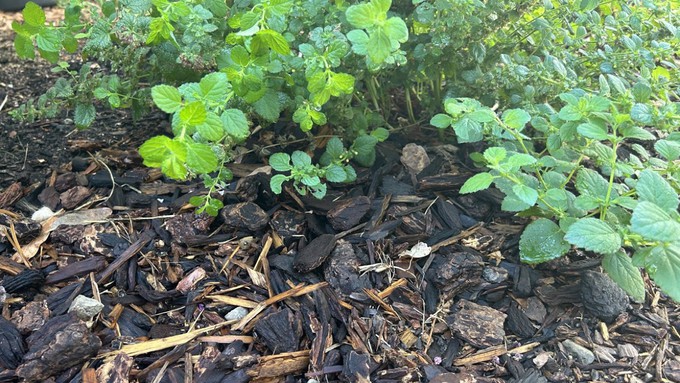
Let nature give you a hand; recycle fallen leaves -- and dig bigger holes

This lemon balm plant is happy and healthy even in hot weather with bark mulch to help preserve soil moisture and keep weeds under control. Kathy Morrison
“There’s got to be an easier way.” How many times have you had that thought while pulling weeds, mowing grass or digging holes?
On this Labor Day, consider how you spend your time in your garden. If it’s all work, there’s no “down time” to relax and really enjoy the results of your efforts. You’re too tired to smell the roses.
With that in mind on this holiday, here are five ways to save labor (and time) in the landscape this fall:
1. Mulch, mulch, mulch!
This simple step saves moisture, cuts down on weeds and helps plants cope with fluctuating weather. Use organic material (straw, leaves, bark, etc.) and that mulch adds nutrients to the soil, too. Avoid rocks or gravel as mulch; they retain too much heat in Sacramento and can “cook” plant roots.
2. Make use of fallen leaves.
This is Mother Nature’s idea of recycling. All those dry leaves that will soon be coming down make excellent mulch and will improve the soil. Mulch also helps suppress weeds, so you’ll spend less time weeding.
Instead of raking up the avalanche of fallen leaves, use the lawn mower to chop them instead. Then, spread this mulch around trees and shrubs. Leave a few inches of space around trunks to avoid crown rot.
Avoid any leaves that show the effects of disease such as peach leaf curl; put those leaves in the trash. If you dispose of that infected foliage, you’ll save time fighting those fungal diseases next year.
3. Use bigger pots.
The larger the container, the less frequently it needs watering. It also makes a greater visual impact and allows plants more room to grow.
4. Choose lower-maintenance, slow-growing plants.
Tired of pruning hedges? Constantly edging borders? Mowing the lawn? Transition your landscape to plants that need less fuss and snipping. It’s a matter of putting the right plant in the right place; it will grow healthier and need less care, too.
5. Dig once, plant a lot.
Fall is planting season for daffodils, tulips, hyacinths and other spring-blooming bulbs. Instead of planting each bulb separately, dig a wide hole to the depth needed and plant several bulbs together. This same idea works for annuals and such cool-season vegetables as lettuce, chard and kale. Dig a single trench, then plant a whole row.
This method also allows for working compost, bone meal or other amendments into the soil all at once instead of little hole by hole.
Comments
0 comments have been posted.Sacramento Digs Gardening to your inbox.
Sites We Like
Garden Checklist for week of July 21
Your garden needs you!
* Keep your vegetable garden watered, mulched and weeded. Water before 8 a.m. to reduce the chance of fungal infection and to conserve moisture.
* Feed vegetable plants bone meal, rock phosphate or other fertilizers high in phosphate to stimulate more blooms and fruiting. (But wait until daily high temperatures drop out of the 100s.)
* Don’t let tomatoes wilt or dry out completely. Give tomatoes a deep watering two to three times a week.
* Harvest vegetables promptly to encourage plants to produce more. Squash especially tends to grow rapidly in hot weather. Keep an eye on zucchini.
* Pinch back chrysanthemums for bushy plants and more flowers in September.
* Remove spent flowers from roses, daylilies and other bloomers as they finish flowering.
* Pinch off blooms from basil so the plant will grow more leaves.
* Cut back lavender after flowering to promote a second bloom.
* It's not too late to add a splash of color. Plant petunias, snapdragons, zinnias and marigolds.
* From seed, plant corn, pumpkins, radishes, winter squash and sunflowers.